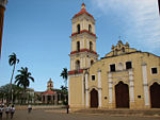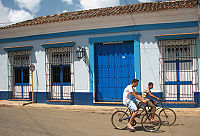
Remedios, Cuba
Encyclopedia
Remedios is a city and municipality
Municipio
Municipio and Município are terms used for country subdivisions. They are often translated as municipality.-Overview:...
located 3 miles (4.8 km) from the northern coast of Cuba
Cuba
The Republic of Cuba is an island nation in the Caribbean. The nation of Cuba consists of the main island of Cuba, the Isla de la Juventud, and several archipelagos. Havana is the largest city in Cuba and the country's capital. Santiago de Cuba is the second largest city...
, in the center of the island. It is part of the province of Villa Clara
Villa Clara Province
Villa Clara is one of the provinces of Cuba. It is located in the central region of the island bordering with the Atlantic at north, Matanzas Province by west, Sancti Spiritus by east, and Cienfuegos on the South. Villa Clara shares with Cienfuegos and Sancti Spiritus on the south the Escambray...
. It was declared a City by Isabel the Second, Queen of Spain, when the Island was still a colony. Remedios is the Cradle of the Parrandas, possibly the Caribbean's largest and oldest traditional festivity.
Remedios is located about 4 hours away by bus from Havana
Havana
Havana is the capital city, province, major port, and leading commercial centre of Cuba. The city proper has a population of 2.1 million inhabitants, and it spans a total of — making it the largest city in the Caribbean region, and the most populous...
, around 50 minutes from Santa Clara
Santa Clara, Cuba
Santa Clara is the capital city of the Cuban province of Villa Clara. It is located in the most central region of the province and almost in the most central region of the country.- History :Santa Clara was founded by 175 people on July 15th, 1689...
and there is less than an hour from there to beach resorts in the Santa Maria - Las Brujas cays both situated north of the province.
History

Trinidad, Cuba
-External links:* , Online travel guide to Trinidad* , Selected photos of Trinidad* , Photos of Trinidad...
(1514) and Havana
Havana
Havana is the capital city, province, major port, and leading commercial centre of Cuba. The city proper has a population of 2.1 million inhabitants, and it spans a total of — making it the largest city in the Caribbean region, and the most populous...
(1515) among others. Rumor has it that Vasco, in order to avoid tax payments to the crown, maintained the village hidden from the knowledge of the King of Spain as long as he could, but the village grew quickly, and at some point it had to be recognized. Through his wife, the daughter of the Cacique of Sabaneque, Vasco received a huge land grant as a personal fief from Gobernor Diego Velazquez as stipulated by Spanish law, therefore it had no municipal entity to govern the town. Upon Vasco's death in Puerto Principe in 1550 the town obtained its charter.
It was originally called Santa Cruz de la Sabana, Santa Cruz de Vasco Porcallo, Santa Cruz de la Sabana del Cayo and lastly by 1578 San Juan de los Remedios de la Sabana del Cayo. In the 16th, 17th and 18th centuries there was a steady progress defined by land grants, which allowed for a stable population settlement. The economic growth relied on agriculture and cattle raising, eventually becoming one of the major beef suppliers to the Florida colonies.
By 1678 the demarcation between Remedios and Sancti Spiritus was already established. Along with cattle raising the sugar industry was developed and by the end of the 17th and beginning of the 18th century the cultivation of tobacco, coffee and cacao was begun. In 1682, a major dispute arose among the settlers, led by Father Gonzalez de la Cruz, who claimed that satanic forces had taken hold of the place. This led the Spanish Crown to send a Royal Decree dated 29 January 1684 transferring the settlement to another place. Only 18 families left the town and went on to establish on the 15th of July 1689 the village of Santa Clara
Santa Clara, Cuba
Santa Clara is the capital city of the Cuban province of Villa Clara. It is located in the most central region of the province and almost in the most central region of the country.- History :Santa Clara was founded by 175 people on July 15th, 1689...
, today an important city in the center of Cuba and the capital of the province of Villa Clara.
Its long history is particularly evident in the city center (declared National Historic Monument in 1980), where 17th century Spanish architecture can still be found intact.
Demographics

Attractions

Remedios is distinguished by many Cubans for its Christmas festival, "Las Parrandas de Remedios", one of the most popular events of the region that takes place between the 16th to the 26th of December every year. Considered the oldest festivities in Cuba, the "parrandas
Parrandas
Parrandas are a traditional carnival-like street party with origins date back to the 18th century. They take place in northern and central cities of the former Las Villas province now Villa Clara, Sancti-Spiritus and Ciego de Avila provinces in Cuba. Most famous parrandas are celebrated in Remedios...
" were initially promoted by Father Francisco Vigil de Quiñones, who used to officiate at the Iglesia Mayor of San Juan Bautista de los Remedios. The priest, who was concerned about the absence of parishioners at the "Misa de Gallo" (midnight mass), had the idea of encouraging children to take to the streets and wake up the citizens using whistles, horns and tin cans, so that they had no other choice than get up and attend mass. That singular and noisy initiative got deeply rooted among the population, resulting in the most attractive festivity in the country. In 1871, the "parrandas" adopted a structure that has survived the passage of time. According to tradition, when the bells of the Iglesia Parroquial Mayor (Major Parochial Church) toll at 9 o'clock on the night of December 24, two neighborhoods make public their creativeness and efforts made during the entire year to participate in the competition. During the "parrandas", a "fierce" competition takes place between the neighborhoods of San Salvador, represented by the colors red and blue, and a rooster as a symbol, and El Carmen, represented by the color brown and a globe. The memory of those celebrations is compiled at the Museum of Parrandas, which opened in a 19th century building in 1980 in Remedios, where photos, documents and hand-made objects linked to the festivities are preserved.

